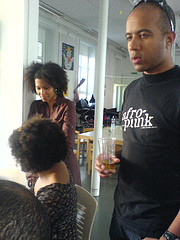Flippant Remarks about Afro-Punk
 Director James Spooner has accomplished, in what appears to be an effortless tour de force, one of the most timely, nuanced, discussion-worthy Black documentaries I have ever seen, Afro-punk. Without the validating testimony of a single Negro college professor, Spooner gathered the interviews of young people “of color” (and a few ex-young people) to cover topics like these (within the context of punk):
Director James Spooner has accomplished, in what appears to be an effortless tour de force, one of the most timely, nuanced, discussion-worthy Black documentaries I have ever seen, Afro-punk. Without the validating testimony of a single Negro college professor, Spooner gathered the interviews of young people “of color” (and a few ex-young people) to cover topics like these (within the context of punk):
- Some self-described “black” people like to be the only “black” person at the “white event” and in such a pose may willfully ignore the other Black person. The multi-faceted reasons why this happens is discussed in the film—a first for me from the ‘younger generation.’
- Some brothers wear dreadlocks because they want their hair to “flow” like hair of Indo-European origin. This seems counterintuitive to folks who assume that dreadlocks always represent an increased ‘sense’ of African culture.
- Black people who have all-white close childhood friends can grow up, get educated and become a part of a “revolutionary black organization”—and still have these white childhood friends.
- Someone in this documentary agrees with me: yes, the term “black rock” is redundant.
- As some young Black punkers get older, the counter-culturalism of the “authentic” punk scene ‘naturally’ makes them interested in their African culture.
- Black women like Tamar-kali Brown (in the film) can find traditional African motifs by exploring the aesthetics (the scarification and piercings) of punk rock.
 I am still amazed at how the team working on this film managed to locate people like Tamar-kali Brown and Mariko Jones. The candid testimony of Mariko Jones is the first time I have ever heard a self-described “black woman” of the ‘younger generation’ discuss her serious tricycle issues with “black guys” openly—how this fear complex was placed in her consciousness by racist lectures from her parents!
I am still amazed at how the team working on this film managed to locate people like Tamar-kali Brown and Mariko Jones. The candid testimony of Mariko Jones is the first time I have ever heard a self-described “black woman” of the ‘younger generation’ discuss her serious tricycle issues with “black guys” openly—how this fear complex was placed in her consciousness by racist lectures from her parents!
To me, one of the most important messages in this film is to see how “black kids” can have all “white” friends and still have this yearning for a Black community. Whatever yearning coming from a brother like me with my “inner city” background has been too often forcibly associated with cartoon misrepresentations of hatred. In other words, a Black man cannot love Black people without hating so-called “white” people. This film goes a long way—with very little effort—to show just how ridiculous this gross misunderstanding can be.
 A very poignant move in the film was to see how these dozens of colored youth in the film were living in “racial isolation”—only Mariko Jones, clearly a relatively pampered child of the suburbs, was determined to be color blind with her situation (although she planned to make a “black-pride” t-shirt). The power of film editing showed them ‘together’ but Spooner makes it clear that few of these colored people of a common interest knew each other. But what this film does without “burning with hate” is to explain—especially to young people like my eldest son—why it is important that Black youth constructively come together under a common (counter-cultural, anti-corporate) interest…
A very poignant move in the film was to see how these dozens of colored youth in the film were living in “racial isolation”—only Mariko Jones, clearly a relatively pampered child of the suburbs, was determined to be color blind with her situation (although she planned to make a “black-pride” t-shirt). The power of film editing showed them ‘together’ but Spooner makes it clear that few of these colored people of a common interest knew each other. But what this film does without “burning with hate” is to explain—especially to young people like my eldest son—why it is important that Black youth constructively come together under a common (counter-cultural, anti-corporate) interest…
It may be that the promotion of the film itself may be a catalyst to organize “black punk” youth culture in the form of afropunk.com. It remains to be seen whether the inter-generational critiques exposed in Kill Your Idols—namely, young people going a bit more ironically corporate compared to the older Bohemian originals—will show up in or around afropunk.com. Black people—even Black punkers—are not magical. Succumbing the lure of paying rent (even a mortgage) with a little sad irony—can be irresistible.

Comments
SJ, 2009-11-30 02:59:34
Not sure why I, an old black punk, didn't know about this film until 6, 7 years after it came out! WTF? Anyway, it was very interesting to hear Mariko Jones say the things she did. Now I know why none of the girls at the hardcore shows of my youth would even look my way. I feel much better now!